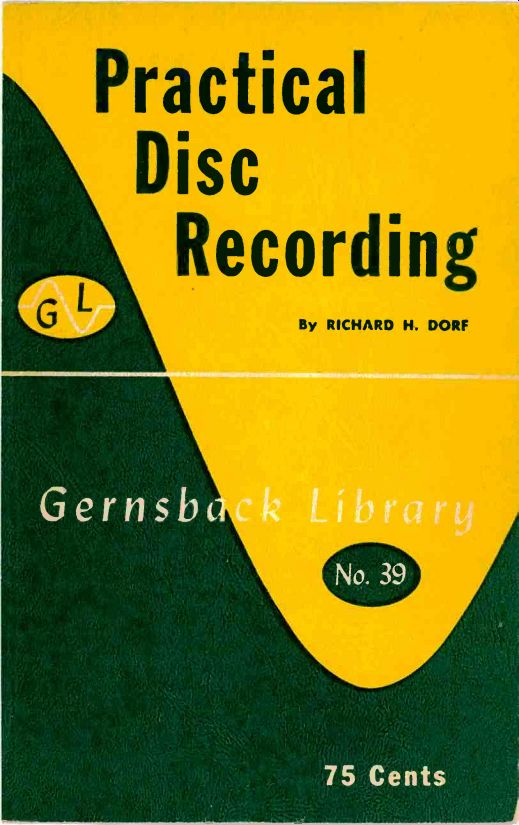Contents
PREFACE (this page; see below)
2. THE DISC
5. THE CUTTER
6. CONSTANT AMPLITUDE VERSUS CONSTANT VELOCITY
7. THE STYLUS
11. EQUALIZATION
13. RECORD PLAYBACK AND DUPLICATION

PREFACE:
THE purpose of this guide is to introduce the radio enthusiast to the art of disc recording and to explain in practical terms the elements of making high-quality records.
Disc recording requires no more mechanical ability or knowledge than the average radioman possesses. It can be a fascinating and productive adjunct to radio, or a business or hobby in itself. Many hours of pleasure and profit can be spent in designing and constructing recording systems.
The owner of a well-built installation can readily acquire an excellent record library of music recorded from the radio and by artists at home, as well as history-making speeches, public events, and personalities. Musical backgrounds, with commentaries, can be provided for home movies. In addition, the serviceman will profit from a thorough knowledge of recording. More and more radios today are equipped to make records as well as play them.
It is expected that the reader has a fundamental knowledge of radio, but every detail of the recording process is described in this guide.
The recordist will find design and construction data for amplifiers, equalizers, and control equipment.
The processes of adjustment and the steps in making a good recording are given in detail. Throughout, the hows and whys of recording are fully discussed, to give the reader a thorough knowledge of the subject.
The type of equipment to be purchased depends on two things: the use intended for the equipment, and the purchaser's pocketbook. It is possible to record radio programs with an initial expenditure of less than $25.00. The results, however, will not bear critical listening and may have little entertainment value. On the other hand, it is possible to spend several thousand dollars for the recording equipment. Naturally, few amateurs are willing or able to spend this kind of money on a hobby. But such an expenditure would not be excessive for some professional installations.
We can only suggest that you let your pocketbook and enthusiasm be your guides. Let us illustrate what we mean. Suppose you wish to make records purely as a hobby and plan to play them on your $45.00 table-model radio-phonograph. The frequency response of such a ma chine at best is about 100-4,000 cycles. Harmonic distortion is probably in the order of 10% to 20%. There is little advantage to be gained from buying high-fidelity recording equipment. True, the high-fidelity recordings will sound a little better, but not enough better to warrant the extra cost. On the other hand, those who enjoy music and have a phonograph capable of reproducing wide-range records should consider high-fidelity recording equipment (if they can afford it). They probably would be dissatisfied with the results from low-fidelity equipment.
When recording for others, professionally, equipment must be as good as you can afford, since it is a business investment. Here, too, intended use supplies the answer to what to buy. Are the customers professional musicians who must have perfect recordings? Or are they less critical average people who are primarily interested in the novelty aspect of hearing their friends' and relatives' voices? Having determined the ultimate use of the equipment, this much is sure: no two people will have to purchase the same items of equipment.
One may have a suitable amplifier on hand, another a microphone, a third a heavy-duty turntable. In this guide, we have attempted to evaluate each part of the whole with this in mind. The reader must deter mine which items he must get, and then balance cost against intended use in determining how much he spends for each part. Naturally, the goal is the best results for the smallest expenditure.
It is our hope that this guide will provide the answers to all the important problems encountered by the recordist, and that it will be of continuing value as a ready reference.
The publishers acknowledge with thanks the cooperation of the following manufacturers in supplying illustrations for this guide:
Figs. 201, 306, 308, 1401-From book "How to Make Good Recordings" Audio Devices, Inc.; Fig. 1111-Cinema Engineering Co. ; Figs. 803, 804-Electro-voice, Inc. ; Fig. 303-Fairchild Camera & Instrument Corp. ; Fig. 403-General Industries Co. ; Figs. 304, 401, 406, 408, 502, 1103, 1112-Presto Recording Corp. ; Fig. 405-Rek-O-Cut Co. ; Fig. 802-The Turner Co. ; Fig. 402-Wilcox-Gay Corp. ; Figs. 503, 605, 805-Brush Development Co. ; Fig. 102-Cook Laboratories.
Also see: Pre-stereo (Monophonic) High-Fidelity Audio: Design, Measurements and Construction